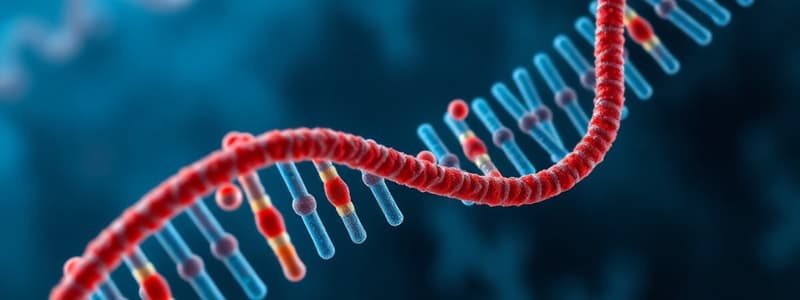Podcast
Questions and Answers
What is the primary function of mRNA in protein synthesis?
What is the primary function of mRNA in protein synthesis?
- To assemble amino acids into proteins
- To store genetic information permanently
- To replicate DNA in the nucleus
- To transport genetic information from the nucleus to the cytoplasm (correct)
How many different amino acids are primarily used to build human proteins?
How many different amino acids are primarily used to build human proteins?
- 25
- 20 (correct)
- 15
- 10
Which part of the DNA structure is specifically responsible for holding the genetic instructions?
Which part of the DNA structure is specifically responsible for holding the genetic instructions?
- Deoxyribose sugar
- Phosphate group
- Nucleotides (correct)
- Histones
Which of the following statements correctly describes RNA's differences from DNA?
Which of the following statements correctly describes RNA's differences from DNA?
What can happen when a mutation disrupts an essential cellular function?
What can happen when a mutation disrupts an essential cellular function?
Which base always pairs with cytosine in the DNA structure?
Which base always pairs with cytosine in the DNA structure?
What is the relationship between mutations and inherited diseases?
What is the relationship between mutations and inherited diseases?
What role do histones play in the cellular structure?
What role do histones play in the cellular structure?
What is the significance of transcription in protein synthesis?
What is the significance of transcription in protein synthesis?
Why is mRNA necessary for synthesizing proteins in the cytoplasm?
Why is mRNA necessary for synthesizing proteins in the cytoplasm?
Flashcards are hidden until you start studying
Study Notes
Protection and Survival
- Mutations can be lethal, disrupting essential cellular function.
- Immune cells can detect and destroy mutated cells.
- Mutations can alter cell function without causing cell death, leading to diseases like cancer.
- Persistent mutations in the genome can be inherited, causing inherited diseases like phenylketonuria or cystic fibrosis.
Protein Synthesis
- DNA contains essential biological information for protein synthesis.
- Proteins are the building blocks of the body and essential for biochemical processes.
- Messenger Ribonucleic Acid (mRNA) carries genetic instructions from the nucleus to the cytoplasm for protein production.
Messenger Ribonucleic Acid (mRNA)
- mRNA is a single-stranded chain of nucleotides synthesized in the nucleus.
- mRNA carries genetic information from DNA to the cytoplasm for protein synthesis.
- Key differences between RNA and DNA:
- RNA is single-stranded, while DNA is double-stranded.
- RNA contains ribose sugar, while DNA contains deoxyribose sugar.
- RNA uses uracil instead of thymine.
Notable Points
- Chromosomes: Composed of tightly coiled DNA, responsible for carrying genetic information.
- Chromatin: Loosely packed DNA, found in the nucleus of non-dividing cells.
- Histones: Structural proteins that help package DNA into chromosomes.
- DNA:
- Composed of four nitrogenous bases: adenine (A), thymine (T), guanine (G), and cytosine (C). Pairs with cytosine.
- Contains deoxyribose sugar and a phosphate group.
Studying That Suits You
Use AI to generate personalized quizzes and flashcards to suit your learning preferences.




